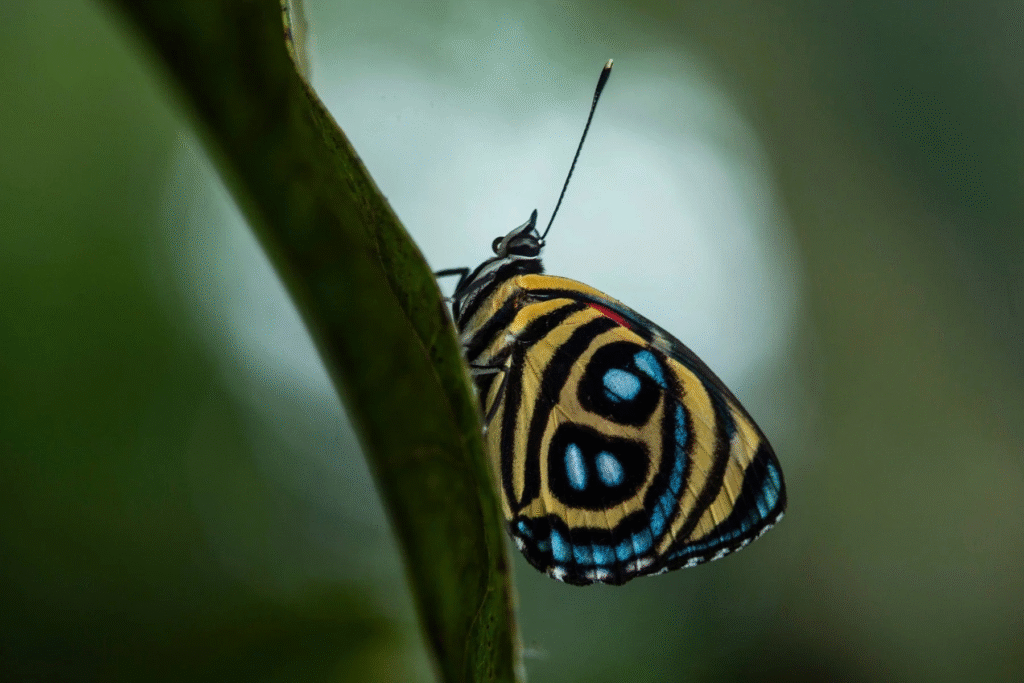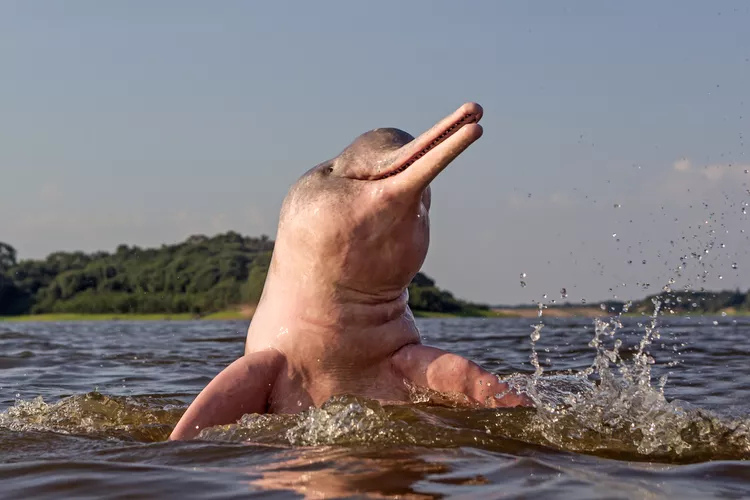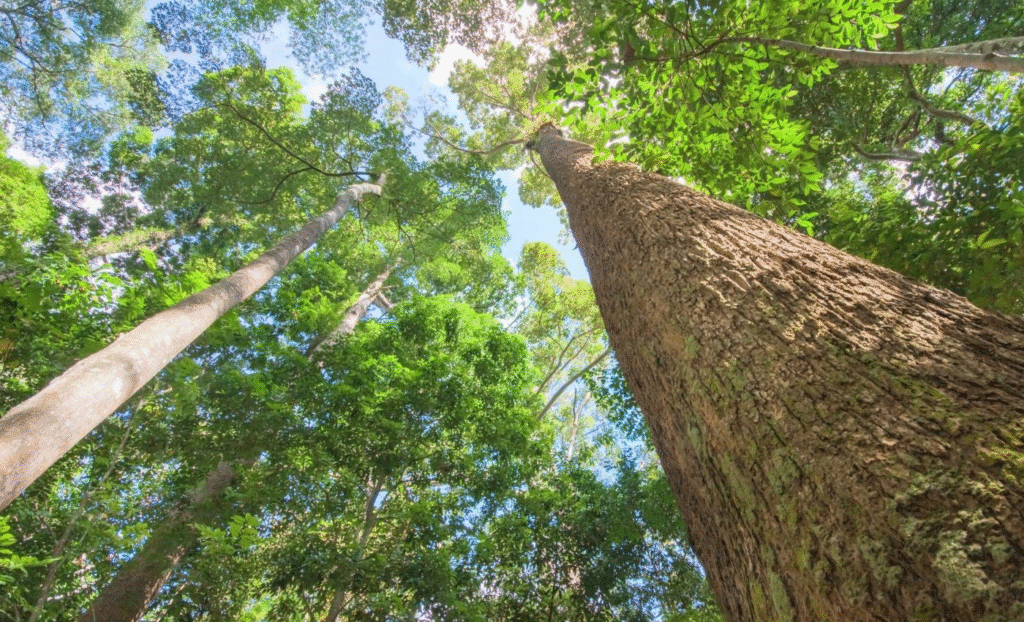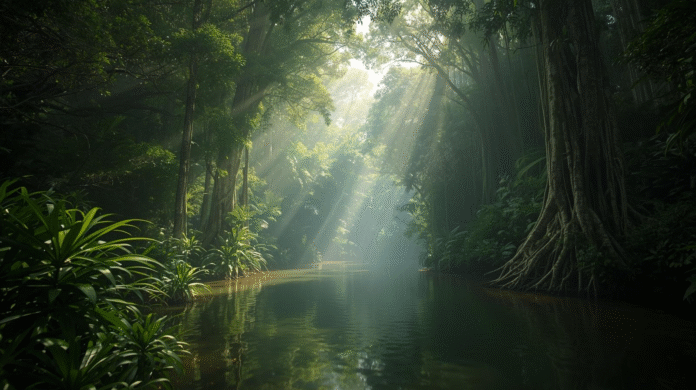Introduction: Beyond the Green Veil
The Amazon Rainforest is not merely a jungle. In fact, it is a colossal, self-regulating planetary engine. This vast biome spans over 6.7 million square kilometers. It encompasses nine different South American nations. Furthermore, the Amazon is the world’s largest tropical rainforest. It is also arguably the most important. Many people understand its basic size. However, the true depth of its ecological and geological wonders remains largely unknown. Therefore, this Vrittonic exposé plunges into the heart of this green behemoth. We will uncover the lesser-known, expert-level facts that define its unparalleled significance. Prepare to have your understanding of Earth’s biology and climate completely reshaped.
I. The Unfathomable Scale: A Statistical Marvel
The sheer magnitude of the Amazon is difficult to process. Consider its geographic scope. The Amazon covers approximately 40% of the South American continent. It is an area roughly twice the size of India. Alternatively, it is 28 times larger than the United Kingdom. Significantly, this massive area is defined by the Amazon River Basin. The basin is an intricate, sprawling hydrological network.
Fact 1: The Amazon’s True River King

Most geography books cite the Nile River as the world’s longest. However, this designation is hotly debated. New studies consistently suggest the Amazon River is the true victor. Its estimated length is now over 6,992 kilometers (4,345 miles). This measurement begins at its newly confirmed source in the Peruvian Andes. Consequently, the Amazon likely surpasses the Nile. It is the definitive longest river globally.
Fact 2: The Water Volume is Staggering
Regardless of its exact length, the Amazon River holds the volume record. It is an undeniable fact. The Amazon discharges a colossal amount of freshwater into the Atlantic Ocean. This volume is estimated at 209,000 cubic meters per second. To put this into perspective, the Amazon alone accounts for about 20% of all river water discharged into the world’s oceans. Indeed, for over 100 miles offshore, the Atlantic Ocean remains only slightly salty. This is due to the enormous freshwater plume.
Fact 3: The Ocean Beneath the Forest Floor
A true marvel of Amazonian geology exists hundreds of feet below the surface. Geologists discovered an enormous underground river system. This system mirrors the Amazon River’s flow. It is named the Hamza River. The Hamza is much wider than its surface counterpart. It is estimated to be over four times the width. The river moves slowly through porous rock. Nevertheless, it carries a significant amount of water. This deep-earth feature highlights the basin’s complex, multi-layered hydrology.
II. The Apex of Biodiversity: Life Without Equal
The Amazon is the world’s champion of biodiversity. It represents the greatest concentration of life forms anywhere on Earth. Scientists estimate that 10% of all known species reside within this biome. Furthermore, the rate of discovery is still incredibly high. A new species of plant or animal is formally documented roughly every other day.
Fact 4: Trees That Rule the World
The forest contains an estimated 390 billion individual trees. This figure is immense. These trees belong to approximately 16,000 distinct species. Crucially, only 227 of these species make up half of the total biomass. This means a few ‘hyperdominant’ tree species shape the entire ecosystem. They create the canopy structure. They also largely dictate the microclimate below.
Fact 5: The Hidden World of Insects

Insects dominate the Amazonian life count. This group comprises the vast majority of species. Astonishingly, a single acre of Amazonian rainforest can host up to 70,000 species of insects. A famous study once found 700 different species of beetles on a single tree. This diversity remains largely uncatalogued. Therefore, the Amazon is arguably the epicenter of Earth’s insect life.Curious about wildlife around the globe? Start with Vantara Jamnagar: India’s 3,000‑Acre Sanctuary
Fact 6: Amphibian Toxicity as Defense
The Amazon is home to 428 classified amphibian species. Many of these are the vividly colored Poison Dart Frogs. Their bright colors serve as a warning. Specifically, the skin secretions of some species are highly toxic. The Golden Poison Frog (Phyllobates terribilis) is one example. It contains enough batrachotoxin to kill ten adult humans. Indigenous hunters traditionally use these toxins. They apply the powerful poison to the tips of their blowgun darts.
Fact 7: The River’s Unseen Life
The Amazon River basin is an unparalleled habitat for freshwater life. It contains over 3,000 species of fish. This is more than 30 times the number of fish species found in all European rivers combined. Moreover, the Dorado Catfish (Brachyplatystoma rousseauxii) holds a world record. It undertakes the longest freshwater fish migration known globally. The fish travels over 11,000 kilometers. This journey goes from the Andes to the Atlantic estuary and back.
Fact 8: Pink River Dolphins are Real

The Amazon River Dolphin (Boto) is a local icon. It is a unique freshwater cetacean. Remarkably, these dolphins possess a distinctive pink hue. This coloration deepens with age. The Boto also has unfused neck vertebrae. This feature allows them to turn their heads 90 degrees. Consequently, they can expertly navigate the flooded forest floors and narrow tributaries.
III. The Planetary Mechanism: Climate and Carbon
The Amazon is rightly called the “Lungs of the World.” This name is an oversimplification, but its role in global climate is critical. The forest acts as a massive carbon sink and a moisture generator.
Fact 9: The Billion-Tree Water Pump
The forest’s trees engage in constant transpiration. This is the process of releasing water vapor into the atmosphere. Incredibly, the Amazon pumps about 20 billion metric tons of water into the air daily. This release is greater than the water flow of the Amazon River itself. This moisture creates an atmospheric phenomenon.
Fact 10: Rivers in the Sky
The vast quantities of transpired water generate a system called “Flying Rivers.” These are atmospheric currents. They carry moisture-laden air across the South American continent. Consequently, these aerial rivers are responsible for rainfall far outside the Amazon. They irrigate agricultural land in central and southern Brazil. This includes the major food-producing regions.
Fact 11: A Carbon Reservoir of Global Importance
The Amazon stores an enormous quantity of carbon. This carbon is locked within its biomass and soils. Estimates suggest this reservoir holds between 90 and 140 billion metric tons of carbon. Therefore, any large-scale loss of the forest releases this carbon. This action significantly accelerates global climate change. It is a critical check against rising global temperatures.
Fact 12: A Self-Sustaining Hydrological Loop
The Amazonian ecosystem is delicately balanced. A significant portion of the region’s rainfall is self-generated. About 50% to 75% of the annual rain is recycled back into the atmosphere by the forest itself. Conversely, losing too much forest disrupts this loop. It could push the biome past a tipping point. This would cause the rainforest to transition into a drier, fire-prone savanna.
IV. Human History and Hidden Civilizations
The Amazon is not an untouched wilderness. It has been home to complex human societies for millennia. Their presence and influence are only now being fully understood.
Fact 13: The Black Earth Secret
Indigenous people dramatically improved the Amazonian soil quality. They did this through a process of careful waste management and burning. This created Terra Preta (Portuguese for “black earth”). This soil is incredibly rich and fertile. It maintains its quality for thousands of years. Furthermore, it is entirely man-made. This fact shatters the old myth of the Amazon being an infertile wilderness. It proves sophisticated, large-scale agriculture was possible.
Fact 14: The Lost Mega-Cities
Archaeologists once believed pre-Columbian Amazonian societies were small and nomadic. New Lidar technology has proven this false. Lidar uses light to map the terrain beneath the dense canopy. In a striking revelation, Lidar has uncovered evidence of vast, interconnected ancient settlements. These were urban systems. They featured huge earthworks, ceremonial mounds, and sophisticated road networks. Some of these date back over 2,000 years. They rivaled Mayan and Incan cities in complexity and size.
Fact 15: The Uncontacted Sanctuary
The Brazilian Amazon is home to the world’s highest concentration of uncontacted tribes. There are estimated to be over 100 such groups. These peoples have chosen or been forced to remain isolated. They maintain a life entirely independent of global society. Crucially, their territories are often the best-protected areas of the rainforest. Their continued isolation is paramount. It protects their health and cultural heritage from outside diseases and disruption.
Fact 16: The Guardians of Biodiversity
Indigenous territories cover a vast portion of the Amazon. Studies consistently demonstrate that deforestation rates are lowest in these areas. Therefore, recognizing the land rights of indigenous communities is the single most effective conservation strategy. Their traditional knowledge and sustainable practices are fundamental. They are the true guardians of the forest’s biodiversity and health.
V. Lesser-Known Fauna and Flora Wonders
The Amazon hides creatures and plants with truly bizarre and extraordinary adaptations. These facts highlight the unique evolutionary pressures of the rainforest.
Fact 17: The Fish That Walks
The Red-tailed Catfish is a fascinating Amazonian inhabitant. However, the most surprising fish is the walking catfish (Clarias batrachus). When its pool dries up, this fish can use its pectoral fins to “walk” across the land. It seeks a new body of water. This remarkable adaptation allows survival in seasonal drought conditions.
Fact 18: Sloths: The Mobile Ecosystems
Sloths are famous for their slow pace. Interestingly, their fur is a self-contained ecosystem. It is often covered in symbiotic algae. This algae provides a perfect camouflage. Moreover, it is eaten by the sloth. In return, a species of Amazonian moth lays its eggs in the sloth’s droppings. This complex three-way relationship is a micro-biome of incredible efficiency.
Fact 19: The Tree That Cries Milk
The Cow Tree, or Brosimum utile, is a remarkable plant. When the bark is scored, it releases a thick, white, edible latex. This liquid is surprisingly similar to cow’s milk. Locals traditionally use it as a drink. Consequently, the Cow Tree provided a reliable source of nutrition in areas where grazing animals were scarce.
Fact 20: The Canopy’s Own River
The emergent layer contains a unique creature. This is the Brazil Nut Tree. It can grow over 50 meters tall. Its seeds, the Brazil nuts, are contained in hard, cannonball-like pods. Crucially, the tree’s pollination relies entirely on specific orchid bees. These bees are only found deep within the undisturbed forest. This interdependence highlights the fragility of the entire ecosystem.
VI. The Modern Scientific Frontier
The Amazon continues to challenge and inform modern science. Recent discoveries change our perspective on its resilience and history.
Fact 21: The Growing Giant Trees

A recent scientific discovery offers a qualified moment of optimism. Researchers found that, in intact Amazonian forests, the largest trees are growing faster. They are growing thicker trunks. This phenomenon is attributed to the CO2 fertilization effect. Higher atmospheric CO2 acts as a fertilizer. However, this only occurs in areas protected from deforestation. This fact underscores the importance of preservation.
Fact 22: Geoglyphs and Ancient Landscaping
The state of Acre in the western Brazilian Amazon holds another secret. Lidar and satellite images revealed hundreds of ancient earthworks called geoglyphs. These are vast, geometric patterns carved into the landscape. They were likely built by ancient peoples for ritualistic or defensive purposes. Furthermore, the presence of geoglyphs confirms a history of extensive, millennia-long human manipulation of the environment.
Fact 23: The Fungi Network
The dense Amazonian soil is connected by a massive underground network. This is the mycorrhizal fungal network. These fungi form symbiotic relationships with tree roots. They significantly increase the trees’ access to nutrients and water. Essentially, this fungal web acts as an underground communication system. It allows trees to share resources and transmit chemical warning signals.
Conclusion: A World Worth Protecting
The Amazon Rainforest is clearly more than just a forest. It is a biological, hydrological, and climatological superpower. Its fun facts are simultaneously fascinating and sobering. They illustrate an immense, interconnected web of life. This system regulates rain across a continent. It sequesters billions of tons of carbon. It hosts a history of human civilization we are only starting to comprehend. Ultimately, the fate of the Amazon is not just a regional issue. It is a planetary concern. Protecting this emerald jewel requires global acknowledgment of its scientific complexity and undeniable value. We must recognize its irreplaceable role in securing a stable future for the entire Earth. Preserving the Verdant Colossus is not merely a goal; it is an imperative. Therefore, support for conservation efforts must become the top priority.





